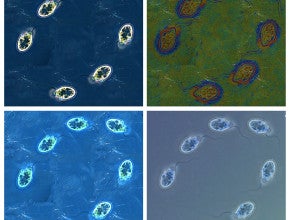This research investigates planktonic predator-prey interactions by combining studies of microscopic cell-cell interactions and responses with measurement of population growth and consumption rates. We can then embed these empirical observations in a theoretically-motivated model that identifies the linkages between organismal behaviors and their population-level ramifications.
The motivation for this study is that although heterotrophic protists are important consumers of phytoplankton biomass and productivity, we still have an incomplete understanding of the processes that drive ecologically relevant rates of plankton growth and mortality. The large number of biological and abiotic variables in the dynamic surface ocean makes it impossible to quantify phytoplankton predation rates by heterotrophic protists empirically.
We combine video analysis of the interactions and population distributions of free-swimming microscopic predators and prey with traditional methods of measuring prey disappearance and predator growth through enumeration at the population level. Together, these three independent measures aim to identify key factors necessary to characterize predator foraging behaviors and success.
Associated Publications
Menden-Deuer 2006; Menden-Deuer & Grünbaum 2006; Menden-Deuer 2010; Harvey & Menden-Deuer 2011; Harvey & Menden-Deuer 2012 .

